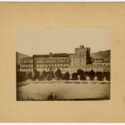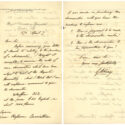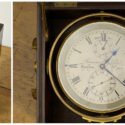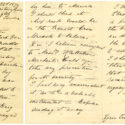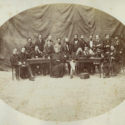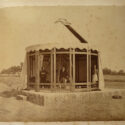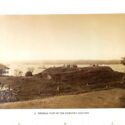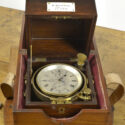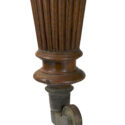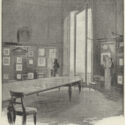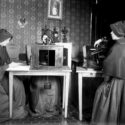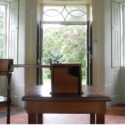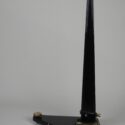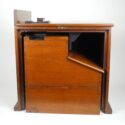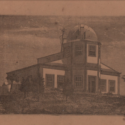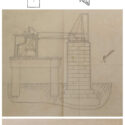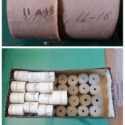Revealing observatory networks through object stories: Object itineraries
Article DOI: https://dx.doi.org/10.15180/232005
Abstract
In this paper, each contribution uses an object biography – or object itinerary – methodology, tracking their chosen objects from conception and purchase, across time and space, to today. The function of each object could change significantly over time, and these stories serve to remind us of the range of projects and activities that observatories might support or host, including overseas astronomical expeditions, a local time service, mathematical calculations, measurement of photographic plates, magnetic, meteorological and seismological observation, the hosting and dining of visitors, and the display and promotion of the observatory’s status. In each case, the object’s movements and location within particular spaces point the reader to consider a wide range of people, whether located within the observatory, beyond its walls, or within international scientific networks. The objects considered here are a London-made marine chronometer purchased by the Palermo Observatory, which was not used for navigation but was nevertheless well travelled; a large wooden table placed in the Octagon Room of the Royal Observatory Greenwich; and a British seismograph set up in at the Meteorological and Magnetic Observatory of the University of Coimbra. These itineraries also show how the value attached to objects changes over time: they shift from functional tools to obsolescence, then regain significance as their histories have been recovered and re-examined. This paper forms part of the collection ‘Revealing observatory networks through object stories’ where object stories are presented in three themed papers (with further papers being ‘Instrumental networks’ and ‘Observatory audiences’). The genesis of the collection is described in the ‘Introduction’.
Keywords
astronomical expeditions, astronomy, chronometer, human computers, meteorological and magnetic observatory, object biography, object itineraries, object stories, observational data, observatory furniture, observatory sites, Palermo Astronomical Observatory, Royal Observatory Greenwich, seismograph, Seismology, timekeeping, University of Coimbra
1. A travelling chronometer, by Ileana Chinnici
https://dx.doi.org/10.15180/232005/001Introduction
A Whiffin chronometer is currently held at the Museo della Specola in Palermo. It is part of a small collection of marine chronometers that were acquired by the Palermo Astronomical Observatory during its more than two centuries of scientific activity. It is, of course, an instrument built for travel, and telling its story makes us, too, travel through time and space. Its ‘biography’ tells us about the mobility of instruments and astronomy. This article describes the circumstances in which it was purchased and the various scientific expeditions on which it was used.

On 22 December 1870, a total solar eclipse was visible from south-eastern Sicily. The Italian government appointed a commission to organise a scientific expedition for observing the phenomenon. Expectations were high because, during the preceding total solar eclipse of 1869, a green emission line had for the first time been observed in the spectrum of the solar corona – an observation which needed to be confirmed. Naturally, astronomers from Palermo Astronomical Observatory were charged with the main preparations, including choice of the station(s), acquisition of appropriate equipment and recruitment of staff (Olostro Cirella, E and Gargano, M, 2016, pp 58–64).
The standard equipment essentially consisted of instruments for astronomical observations, time determination, and measurement of meteorological parameters. In addition, however, instruments for spectroscopic and polarimetric observations, devices for measurements of solar radiation and geomagnetic variation and photographic apparatus were regularly used, especially after 1860. Time measurement was the most important operation to be done before, during and after the eclipse, in order to have an accurate determination of the instants of the contacts and ensure that the observations were comparable to the others. Consequently, having reliable chronometers was crucial.
At the time of its foundation, around the end of the eighteenth century, most of the clocks of the Palermo Astronomical Observatory were made in London. British clockmakers were still leaders in the construction of astronomical pendulums and chronometers in the nineteenth century and director Gaetano Cacciatore (1814–89) decided to follow the steps of his predecessors. On 15 March 1870, he wrote to the British Astronomer Royal, George B Airy, to ask for his advice on purchasing a reliable chronometer for the Observatory to be used during the expedition. Airy, who in 1840 had resumed the service of testing English clocks at the Royal Observatory of Greenwich (Dolan, 2014–23), replied:
…before answering your letter of March 15 relating to the purchase of a chronometer, I thought it desirable to examine the rates of some chronometers which have been subject to trial at the Royal Observatory. And I think that I can with confidence recommend to you the chronometer Whiffin 342 at the price of £40 English, or about 1000 francs.
If you decide on purchasing this chronometer, will you have the kindness to inform me, –
1. How is payment to be made to the chronometer-maker?
2. How is the chronometer to be transmitted to you?[1]
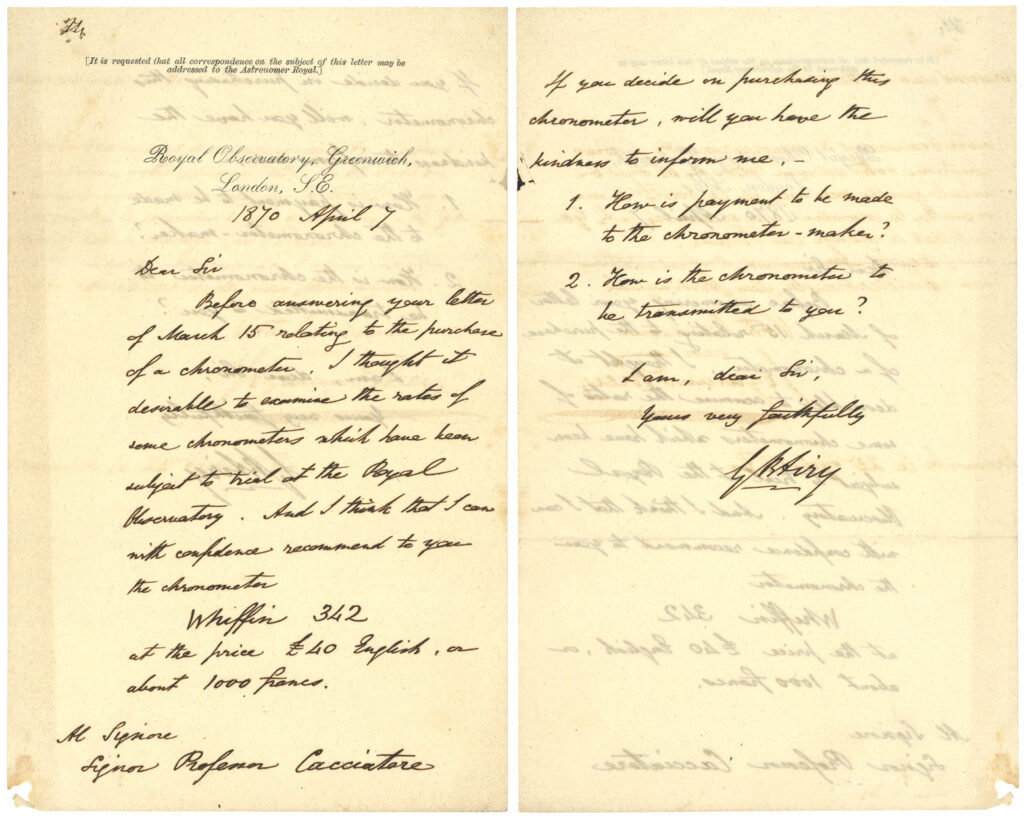
Swann Whiffin (1822–74) was a chronometer maker who worked in London and mainly produced marine chronometers.[2] This kind of chronometer, being sufficiently accurate and easy to transport, was ideal for scientific expeditions. Cacciatore, relying on Airy’s advice, purchased the Whiffin No. 342 chronometer. For his part, Airy was so convinced of the good quality of the instrument that he interrupted its trial in order to sell it to Cacciatore: it was ‘withdrawn by the maker, by permission’ (Airy, 1871a, p 3).
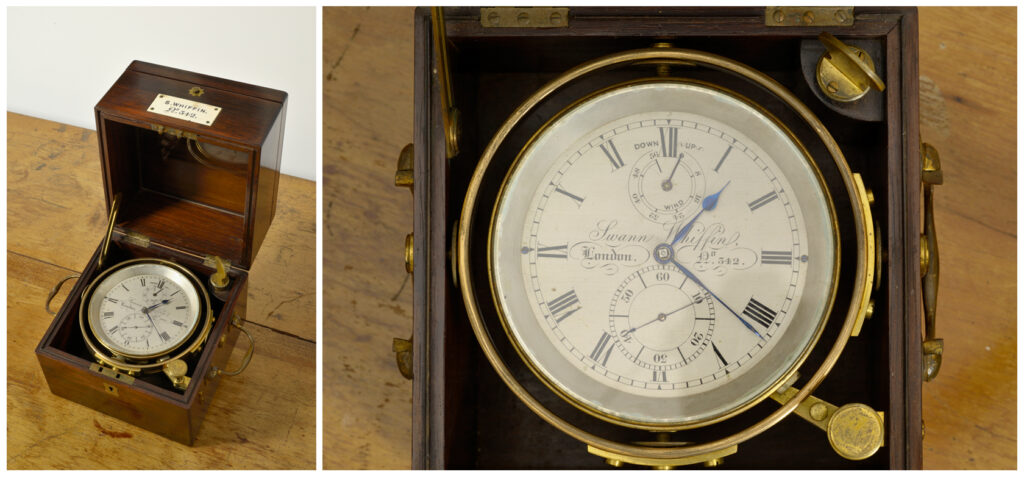
Transport to Sicily
The chronometer thus started its first journey. Whiffin wrote to Cacciatore:
A Chronometer made by me, which for the last four months has been on trial at the Royal Observatory Greenwich, and purchased on your behalf by Professor Airey [sic], was last week entrusted to Captain Robinson of the Brig “Emily” to be conveyed by him to Marsala. I should think its chief risk would be on the transit from Marsala to Palermo. If so, I believe consigned to Mess.rs Whittaker [sic] Merchants. Could you take any precaution for its security[?]
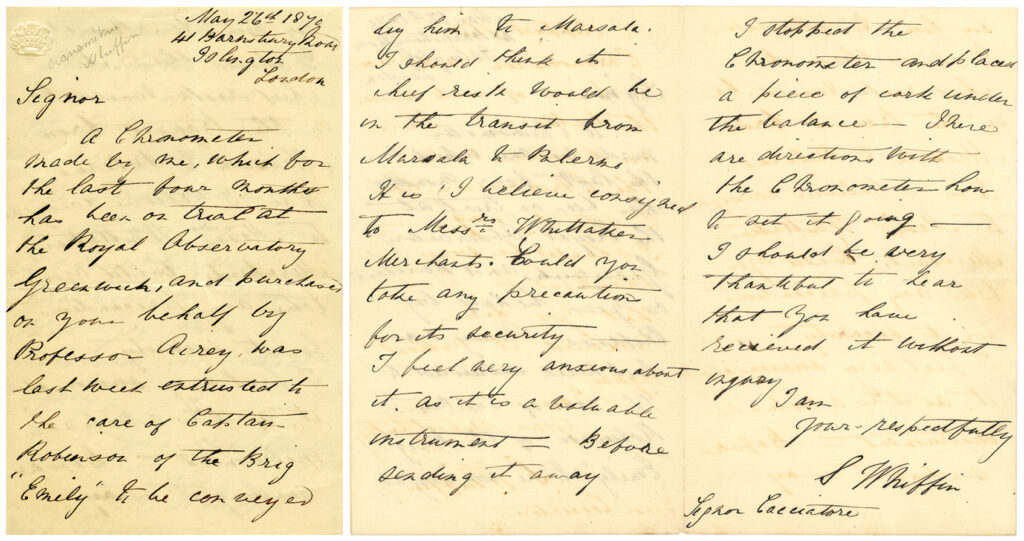
Whiffin had chosen to make use of pre-existing political and commercial links between Britain and Sicily. The best and fastest way to travel between the two was to follow the well-established route of wine, in place since wealthy English families had become producers and merchants of Sicilian wine in the first half of the century. A renowned wine factory was established in Marsala by Benjamin Ingham – cloth merchant and banker in Palermo – and his nephew Joseph Whitaker (AMSP, 1985). The Ingham-Whitaker family had a small commercial fleet which sailed both the Atlantic and the Pacific. In 1840 a young friend of theirs, Vincenzo Florio, joined with Ingham to establish an innovative and efficient steamboat company (also for trade in sulphur products), which gained an excellent reputation for almost a century. Thus, the chronometer was shipped on board a brig of the Ingham-Whitaker fleet.
Despite the experience of wine merchants in dealing with expensive and fragile cargo, and the fact that chronometers were made to travel, Whiffin’s concern was clear. ‘I feel very anxious about it’, he wrote, ‘as it is a valuable instrument.’ He took care in packing, noting that ‘Before sending it away I stopped the Chronometer and placed a piece of cork under the balance’, providing instructions for how to set it going again. ‘I should be very thankful to hear that you have received it without injury.’[3]
Cacciatore also knew a reliable connection to minimize risk of damage or loss. Once the Emily had reached Messina – the first stop in a Sicilian port – it could be shipped onboard a steamboat of the Florio fleet, sailing to Palermo. He thus wrote to William Ingham Whitaker, son of Joseph Whitaker and company administrator, who reassured him: ‘I have already written to Capt[ain] Robinson of the Schooner “Emily” in Messina, asking him to deliver the chronometer to the Adm[iral] of the Florio steamboats of that town, as you requested.’[4]
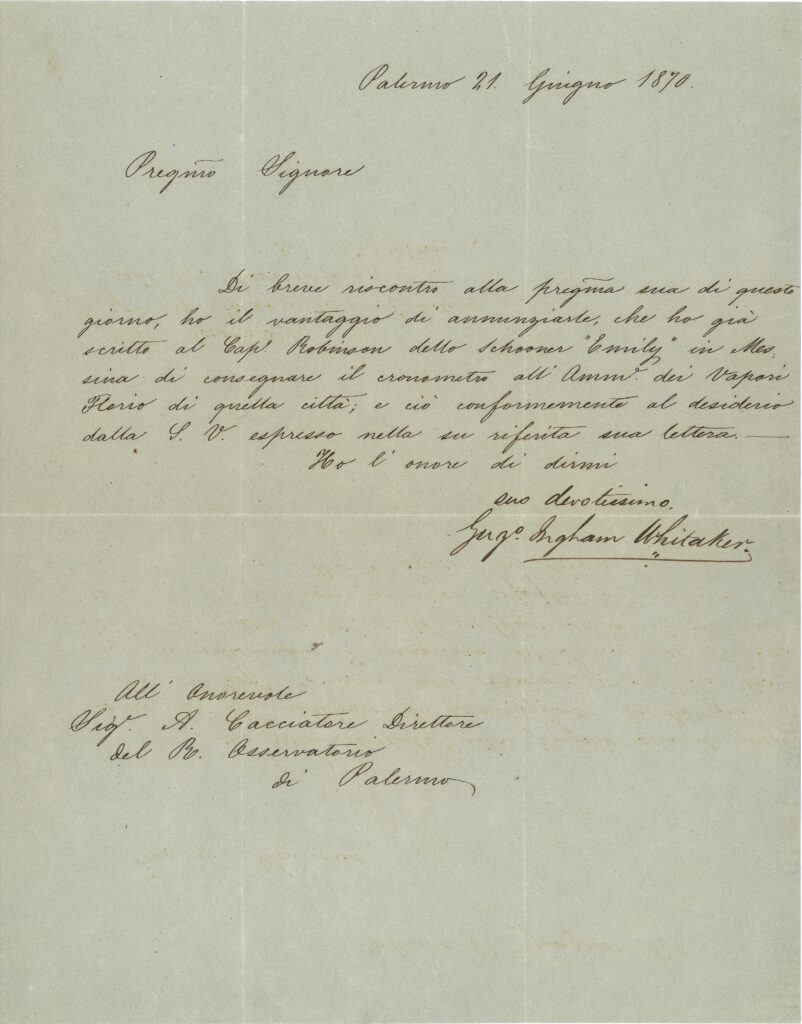
On 12 July, the chronometer was in Palermo. Pietro Tacchini (1838–1905), adjoint astronomer to Palermo Observatory, was informed about delivery and payment details:
We are pleased to inform you that the Chronometer ordered by you through the agency of Mr. William Ingham Whitaker has arrived. We would be grateful if you would now send someone to collect it… The cost of the Chronometer, as you will have been informed, is £ 40, that at the exchange rate of 26 comes to 1,040 Italian lire which you can pay to us with the addition of 85 cents for our minor expenses.[5]
Whiffin 342 on expedition
It is unclear if the chronometer was left packed until the departure of the expedition in November, as no mention has been found about tests at Palermo Observatory. In any case, its final destination was Augusta, on the eastern coast of Sicily, where an astronomical station was built for the purpose of observing the eclipse. Along with other instruments forming the expedition equipment, Whiffin 342 was again shipped, this time onboard a steam corvette of the Italian navy, the Plebiscito, to be transported to Augusta (Cacciatore, 1872, pp 4–5). Something, however, went wrong. Other marine chronometers, on loan from other Italian observatories, were used for the time determination and, by comparing their rates, it was evident that time measurements taken with the Whiffin chronometer had to be discarded:
…the Whiffin chronometer…was later recognised as unsuitable, because it showed variations and highly irregular jumps when it was moved from one place to another, perhaps as a result of damage sustained during the journey (Cacciatore, 1872, p 36).[6]
Nevertheless, the chronometer was not discarded. Though no evidence has been found, it is highly probable that it was repaired, because four years later it was used for another scientific expedition.
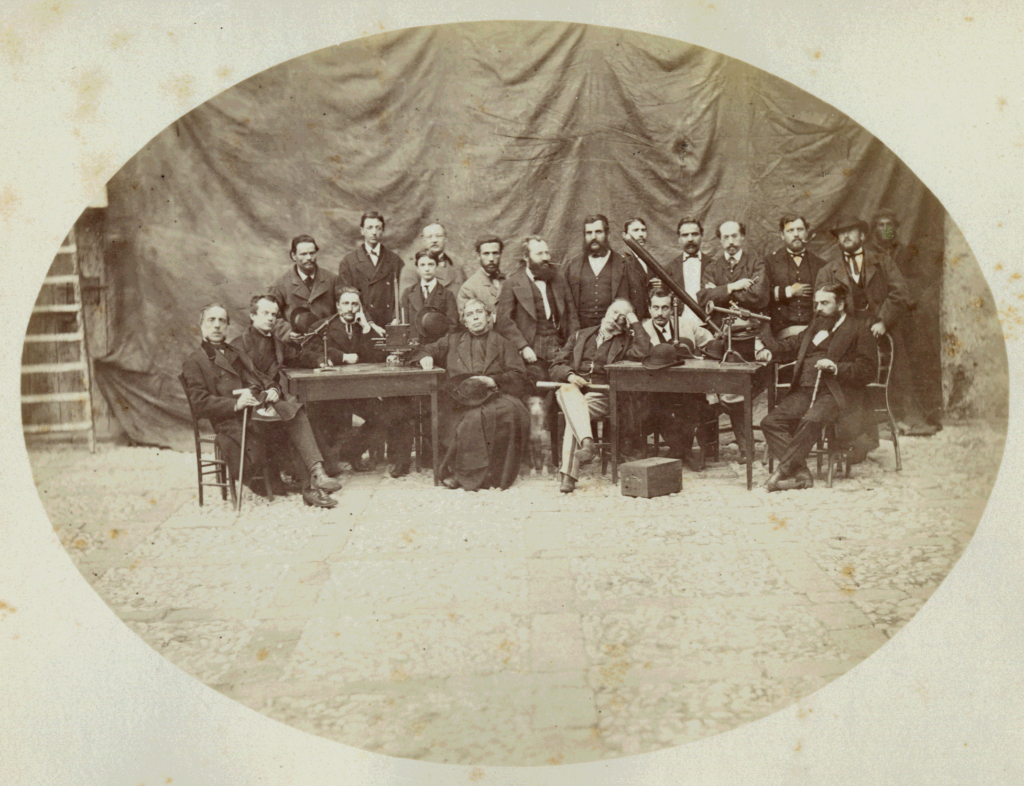
On 9 December 1874 a transit of Venus across the Sun’s disc was visible from many regions of Asia and Australia. This rare phenomenon provides an extraordinary opportunity for accurate measurements of solar parallax, from which the Earth-Sun distance can be trigonometrically derived if observed from at least two, and ideally multiple, stations at a distance from each other. The Italian government lacked the means to support many expeditions and so Tacchini proposed just one, with a special purpose: to observe the transit spectroscopically for the first time. This was an attempt to gain a clearer view of the crucial moments of ‘contact’, when Venus appeared to touch the solar limb, in order to compare the measurements of the solar disk’s diameter obtained by ordinary and by spectroscopic observations. An accurate determination of their difference would provide important information about the extension and nature of the outer solar atmosphere.
Following the suggestion of Arthur Auwers, director of Berlin Observatory, the small Italian party headed by Tacchini (a mechanic, one amateur and three professional astronomers) chose to observe the phenomenon from Bengal, in Muddapur (today Madhupur), near Calcutta. Tacchini brought Whiffin 342 from Palermo Observatory for time determination, as well as a Dent chronometer on loan from the private observatory of Marquis Raimondo Montecuccoli in Modena.
Mindful of the irregular rates that the chronometer had shown in Augusta, before the departure to Bengal, Tacchini asked to test it at Padua Observatory (Abetti, 1875, p 50), where all the equipment to be sent to India was stored. The chronometer worked with the required regularity. Together with the rest of the equipment (about seventy crates) and the observing party, it was shipped on the Sumatra, a steamboat of the English Peninsular and Oriental Company, sailing directly from Venice to Calcutta. The journey was quite troubled. Due to the failure of the steamboat’s propeller at Alexandria in Egypt, the party reached Suez by railway to meet the Surat, a steamboat bound for Calcutta, which unfortunately was late. Tacchini then decided to change plans and, without waiting the arrival of the Surat, opted to ship men and instruments onboard the steamboat Ceylon, destined for Bombay via Aden. Once in Bombay, the crates were landed and three of them got broken, fortunately those containing materials for building the barracks for the astronomical station. Thanks to the assistance of the local Italian Consul, the baggage was loaded onto the carriages and the party left by railways for Muddapur via Allahabad.
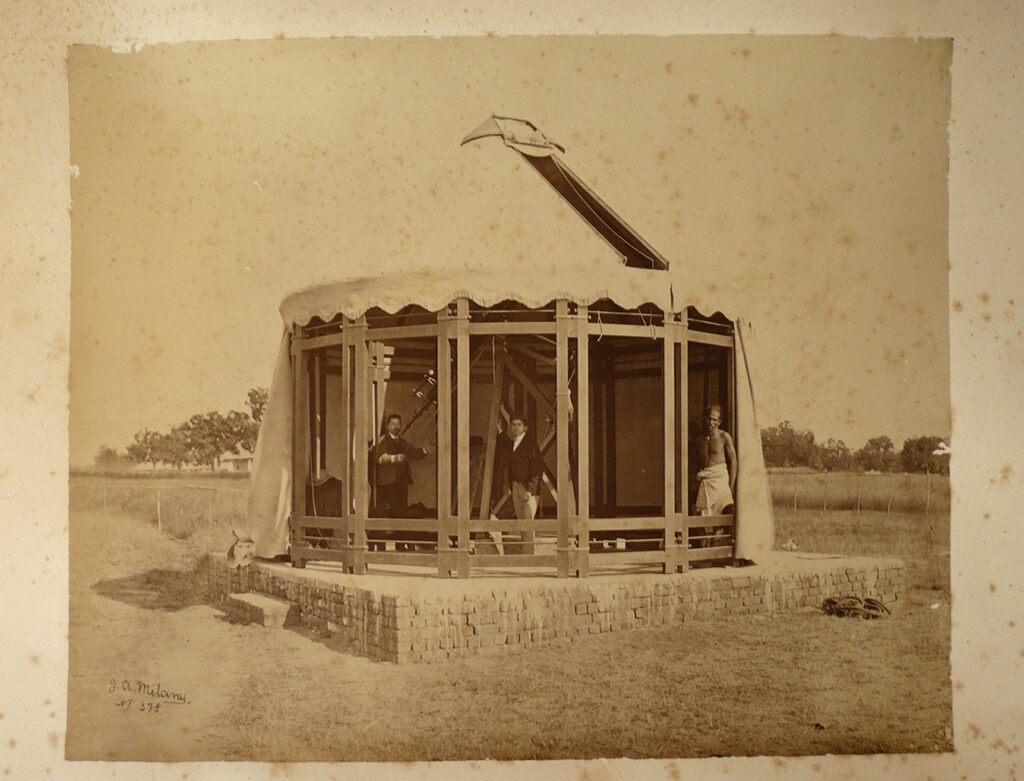
The Whiffin chronometer was used for local time determination (Muddapur Mean Time). Tacchini had previously contacted Norman R Pogson, astronomer in Madras, who agreed to assist the Italian party in the telegraphic determination of the longitude of Muddapur. Whiffin 342 was used to measure the time interval of 10 seconds of a first series of intermittent telegraphic signals sent from Muddapur to Madras for about 15 minutes. Pogson replied with a similar series of signals from Madras. The same operation was repeated from Muddapur with the Dent chronometer. All time signals were recorded in both stations and, from their comparison, after local time corrections and telegraphic signals later sent from Calcutta, the difference of longitude between Madras and Muddapur was determined (Tacchini, 1875b, pp 87–88).[7] These observations were essential for the processes of correcting the transit observations and comparing them with others made around the world.
Both chronometers (Whiffin and Dent), however, ran irregularly. This was evident after the time determination by astronomical observation was completed by Antonio Abetti, who calculated the corrections of the chronometers. He explained the irregular running was ‘mostly due to the strong variations of temperature which are inevitable in places only sheltered by canvas’ (Abetti, 1875, pp 50–51).
A few months later, the Whiffin chronometer had to render other services to science. While in Bengal, Tacchini was invited by the Royal Society to participate in the English expedition to the Nicobar Islands for observing and making spectroscopic observations of the total solar eclipse of 6 April 1875 (Waterhouse, 1875, p 6). The Italian party separated. While the others went back to Italy, Tacchini, with the mechanic Antonio Cagnato from Padua Observatory as his assistant, joined the English expedition. Tacchini brought the Whiffin chronometer. The expedition was divided into different groups and Tacchini was the only astronomer of the party settled at Camorta; he was therefore in charge of calculating the time of the contacts and gave assistance to setting up the instruments (Waterhouse, 1875, pp 7, 16). The Whiffin chronometer was used for measuring the time of the contacts (Tacchini, 1875a, pp 22–24).
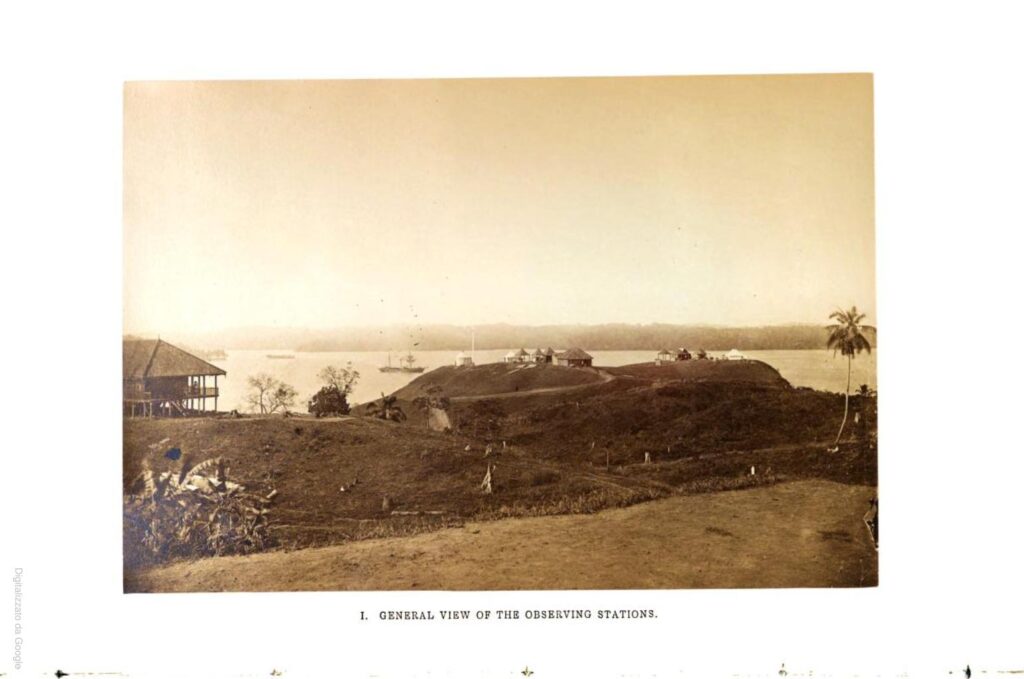
Once back to Palermo, the chronometer was still used at the Observatory, as it is mentioned among the main instruments in use (‘principali strumenti in esercizio’) in a report by Cacciatore (1882, p x).
It is unclear if it was also brought to Russia by Annibale Riccò, astronomer at Palermo Observatory, who went to observe the total solar eclipse of 19 August 1887 in the small village of Surwiskaja, together with Tacchini. In the latter’s report, the only instruments which he mentions are telescopes (Tacchini, 1888, p 211), but it is obvious that a chronometer would be included in the essential equipment that they brought from Italy.
A few years later, the instrument was certainly used for determining the time of the contacts during observations of the solar eclipse of 17 June 1890, made at Palermo Observatory and coordinated by Riccò (Riccò, 1891, p 122).
Whiffin 342 in Palermo Observatory
Back at the Observatory, Whiffin 342 played an important role. A report published in 1904 by director Filippo Angelitti stated that ‘An excellent marine chronometer, with half-second steps, made by Whiffin, No. 342, is regulated to mean time and is used for the noon signal’ (Angelitti, 1904, p 34).[8] It was, in other words, being used for the city’s time service, one of the most important tasks of astronomical observatories.
About forty years after its acquisition, therefore, the Whiffin chronometer was still in use and regulating a crucial service. For this reason, it probably stopped travelling. In the report of the scientific expedition to Sfax for observing the total solar eclipse of 30 August 1905, Temistocle Zona, an astronomer from Palermo Observatory, did not mention any chronometer in the equipment (Zona, 1908). It is unlikely that none was included, but other chronometers were available at that time at the Observatory and were probably preferred to the old one.
The Whiffin chronometer is now ‘retired’ and at rest in the Museum of the Palermo Observatory, together with two other marine chronometers, made by McGregor and Nardin. Kept for its historic value, it is well preserved and still equipped with its padded wooden travel box, seeming ready to travel once more in the interest of science. It is decidedly the instrument of the Observatory that has travelled the most and today it illustrates the connections between instrument makers and astronomers in different countries, and between commercial and scientific networks. It also underscores the essential role of timekeeping in allowing astronomy to be carried out globally.

2. Invisible support: the Octagon Room table of the Royal Observatory, Greenwich, by Louise E Devoy
https://dx.doi.org/10.15180/232005/002Introduction
part of the furniture, something familiar enough to be regarded as a permanent feature (and therefore taken for granted). colloquial.
Oxford English Dictionary
The purpose of this study is to trace the object itinerary of an item that had no direct astronomical use but was a key part of the Royal Observatory’s administrative infrastructure that facilitated networking events with both professional and public visitors. The object of study is a long, multi-sectioned table with oval ends that was used in the Octagon Room within Flamsteed House, the oldest part of the Observatory site. Made in the nineteenth century, it is the only surviving piece of observatory furniture within the collections and is currently held in storage.[9] With no distinguishing features and few archival sources, we can only infer its object itinerary alongside the changing functions of the Octagon Room, from meeting room to computing space and social venue. Unlike the other objects described in this issue, the Octagon Room table did not travel along networks (cf. Chinnici in ‘Object itineraries’), was not used for public spectacle (cf. Raposo, ‘Observatory audiences’) and did not help promote the Observatory across international networks as a recommended instrument (cf. Figueiredo,‘Object itineraries’ and; Biro,‘Observatory audiences’). Yet the very nature of its invisibility makes it worthy of study as an opportunity to examine the mundane material culture of the Observatory’s working environment, beyond its famous clocks and telescopes.
Description of the table
Made of quarter-sawn oak for maximum stability, the table is composed of two oval end sections and seven rectangular leaves for the centre section (Figure 1). It has an extendable frame underneath to support the additional leaves and stretches to 4.7 metres (15.5 feet) when fully assembled. At first glance, the reddish hue of the wood suggests mahogany but the prominent medullary rays reveal the table’s construction from the cheaper option of oak. Typical of a standard mid-nineteenth century extendable dining table, this example stands on eight turned legs with vertical reeding (Figure 2). The metal casters have a corresponding set of wood chocks or coasters to protect the floor from pressure points and to reduce any movement. Looking more closely, one can see some flakes of red colour on the casters that suggest that it was moved across a red-coloured floor at some point in its history.[10]
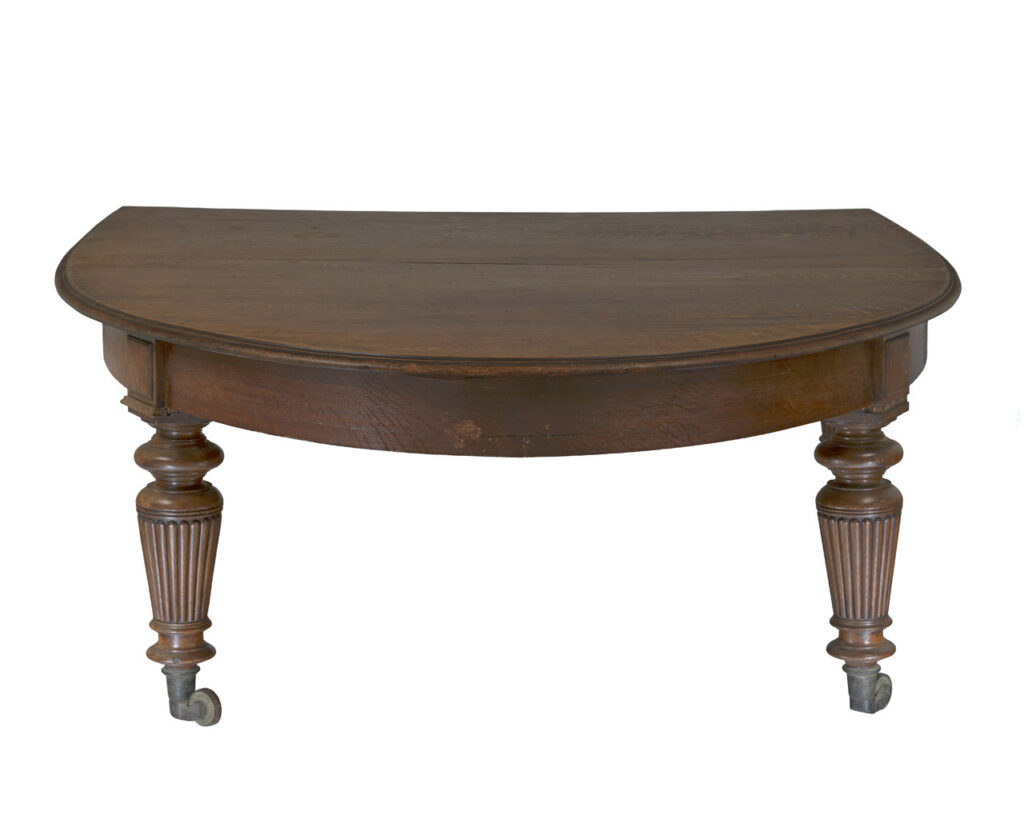
Sadly, there are no visible marks or stamps that can help us identify the manufacturer or supplier but we know from other Observatory records that the seventh Astronomer Royal George Biddell Airy (1801–1892) sourced furniture in 1836 from a ‘Mr Tenton’.[11] This implies that Airy relied on known suppliers and craftsmen for supplying the more mundane aspects of the Observatory’s infrastructure.[12] In contrast, his successor William Christie (1845–1922) sourced items via the Admiralty’s Director of Stores from 1883 (Christie, 1884, p 3). In his Annual Report for 1870, Airy mentioned that ‘Care has been taken to brand with the Observatory mark [a broad arrow with a star] the wooden instruments and furniture of all kinds’ (Airy, 1871, p 6) but no such marks have been found. Today, the table is in relatively good condition with only minor surface scratches and some cracks in the oval ends, approximately 20cm in length, possibly caused by the wide variations in heat, moisture and light exposure in the Octagon Room over its decades-long service.

The context of the Octagon Room
With little physical evidence from the table itself, we can only infer its purpose and function from its situation within the Octagon Room, at the heart of Flamsteed House, the oldest part of the Observatory that is named after the first Astronomer Royal, John Flamsteed (1646–1719). Our table seemingly first appears in the inventory for 1864 in which a later pencil note has been added alongside the ink-written listings of the Octagon Room to include ‘17 chairs, one large table’.[13] Eight years later we find in the ‘Additions and Alterations’ that ‘A set of 18 mahogany chairs has been added’,[14] which is subsequently clarified two pages later as ‘16 mahogany chairs, 2 ditto arm chairs’.[15] Another note in the inventory for 1887 mentions ‘One large table, 16 Chairs (Wardroom)’.[16] The most specific listing occurs in the inventory for December 1895, made by ‘H.O’ [Henry Outhwaite, Clerk], that states ‘Octagon Room; Table, dining, oak, with leaf, total length 17 feet. Width 6ft 6in. Chairs, wardroom, arm, 2; Chairs, wardroom, 16.’[17]
If we assume that this ‘large table’ is indeed our table of study, we can use the changing function of the Octagon Room to deduce its likely role within observatory bureaucracy. The eight-sided room was originally designed by Christopher Wren and Robert Hooke in 1675 and was known as the Camera Stellatum (‘Star Room’) or ‘Great Room’ (Howse, 1975, p 4 and Figure 2). But with better observing facilities available elsewhere on site, the room was little used and became a storage space for publications and redundant instruments.
Our clearest indication of the room’s furnishings appears over 150 years later when Airy conducted an inventory of the Observatory’s holdings upon his appointment in 1835. Listings for the ‘Great Room’ show that the space had been become the de facto museum of small-scale Observatory relics and bequests with a variety of astronomy-themed engravings, busts, oil paintings and technical models, including the timekeepers of John Harrison and Larcum Kendall.[18] These items reappear in later inventories, including where we first encounter the listing of ‘a large table’ in 1864. The elegant design and capacious dimensions of the table are consonant with the Octagon Room’s function as a museum space for the purposes of impressing official guests and reinforcing the institution’s lengthy history and prestigious status within science. Although the Octagon Room was primarily used as a museum for the remainder of the Observatory’s working life, it was also repurposed for specific events and temporary projects that reflected the changing nature of astronomy in the late nineteenth century, including meetings, computations and social events.
Use as a table for meetings
One of the most important functions of the Octagon Room was to serve as a meeting room for the Annual Visitation by the Board of Visitors, normally held from Airy’s time onwards on the first Saturday of June. Intended as a group of scientific peers who could check upon the work and funding of the Observatory, the Board of Visitors had undergone many changes since its origins in 1710 and was reconfigured in 1830 with a new combination of delegates from the Royal Society and Astronomical Society (awarded its Royal Charter in 1831[19]) (Laurie, 1966).
The first meeting under Airy’s tenure took place at Kensington Palace in 1835, home of the serving President of the Royal Society, the Duke of Sussex, but subsequent Visitations were made to the Observatory itself (Laurie, 1967, p 336). After 150 years of controversy over lost, incomplete and inaccurate publications by various Astronomers Royal, Airy was keen to show the Visitors the efficiency and productivity of his staff. In his Annual Report for 1837, he describes his approach: ‘The state of printing of the volume for 1836 will appear from the proof-sheets laid on the table’ (Airy, 1840, p 4). This visible display of the Observatory’s outputs, laid out on the largest table available, shows how this seemingly innocuous piece of furniture was in fact an important part of the institution’s bureaucratic rituals, intended to reinforce the accountability, integrity and public value of both the Astronomer Royal and his staff.
Use as a computing table
Under Airy’s tenure, the Octagon Room assumed a new function as a calculating room in which human ‘computers’ undertook the laborious task of processing (‘reducing’) the raw observational data into a corrected format ready for publication. Having computers onsite was a relatively new approach. The fifth Astronomer Royal Nevil Maskelyne (1732–1811) had created a small but nationwide network of computers who worked at home to generate the predicted astronomical data required for the Nautical Almanac (Croarken, 2002, pp 112–122). By the 1820s, his successor John Pond (1767–1836) had persuaded the Admiralty to pay for six new assistants to work at Greenwich – two of whom were specifically assigned as computers – to meet the growing demand for more astronomical observations and the new chronometer trials (Dolan, 2014–2023a).
When Airy arrived in 1835, he secured additional funding to continue with the reduction of the historic lunar and planetary observations made at the Observatory during the period 1750 to 1830, a project that he had already instigated several years previously as Director of Cambridge Observatory (Belteki, 2023). He hired two teenage ‘supernumerary computers’ specifically for this work,[20] namely the brothers Richard and Edwin Dunkin, who were recommended to Airy via contacts of their father, William Dunkin, previously a computer himself for the Nautical Almanac. In his autobiography, Edwin describes the scene from when he first arrived on Tuesday 21 August 1838:
I can well remember my first day’s work. We were at our posts at 8 a.m. to the moment. I had not been many minutes seated on a high chair before a roomy desk placed on a table in the centre of the Octagon Room, when a huge book was placed before me… (Dunkin and Hingley, 1999, p 72).
It is tempting to speculate that our table of study was the central table but the available evidence in the archives seems to suggest otherwise. Firstly, it does not match the description of the furniture as listed for 1837, just a year before: ‘3 Painted deal [pine] Tables tops covered with green baize (worn) 6.0 [feet] x 2.10 [feet] each’[21] and by May 1840 the inventory only contains a vague mention of ‘5 tables. 6 writing desks (to place upon tables)’.[22] Secondly, the Reductions project only continued for eight years (Dolan, 2014-2023b), finishing nearly two decades before the first mention of a ‘large table’ in 1864. Thirdly, the table is relatively pristine, unlike its counterparts in the Computing Room in the Meridian Observatory which suffered from inky patches, leading Airy to request the carpenter to plane the desks every few years.[23] With no such stains or repairs evident on the leaves, it seems unlikely that the large table would have been used for these computations, unless it was covered in green baize, similar to the smaller pine tables.
In contrast, we have two other subsequent computing projects in which the table may have indeed played a role. In November 1887, work began on the Meridian Observatory to extend the Computing Room and to erect a new 18-foot diameter dome that was intended to house a six-inch Cooke refractor with photoheliograph attachment but was later filled with a 13-inch Astrographic Equatorial telescope. To facilitate these new developments, Christie moved the Assistants and Computers to temporary office accommodation in the Octagon Room (Christie, 1889, p 3; Christie, 1890, p 3). Again, we can only speculate that this table may have been used, or else it might have been dismantled and stored elsewhere during the upheaval. By September 1890, Christie was keen to recruit more staff with the observations and photographic data analysis required to support Greenwich’s contribution to the ambitious international project to create a photographic atlas of the sky (Carte du Ciel). Like several other observatory directors involved with the project, Christie minimised his staff costs by recruiting four women as ‘lady computers’ (Dolan, 2014–2023c), a decision that attracted some attention in the London press. One such article published in June 1891 mentions that:
One room in particular, the octagon, is especially interesting, as being the observatory of Flamsteed, the first Astronomer Royal. It is here that the women do their computations, surrounded by the portraits of illustrious astronomers, who being dead yet speak, telling of the triumphs of industry, ingenuity, and genius, which recognize no distinction of sex, and are no prerogative of a class (Clemes, 1891).
Here we see the Octagon Room assume a dual function as both a museum and as a computing room. Based on the evidence seen in other publications of the period (Figure 3), we can be reasonably confident that this large table was present and was used by the women computers as described above. Whether the space was used exclusively by the women or not is unclear.
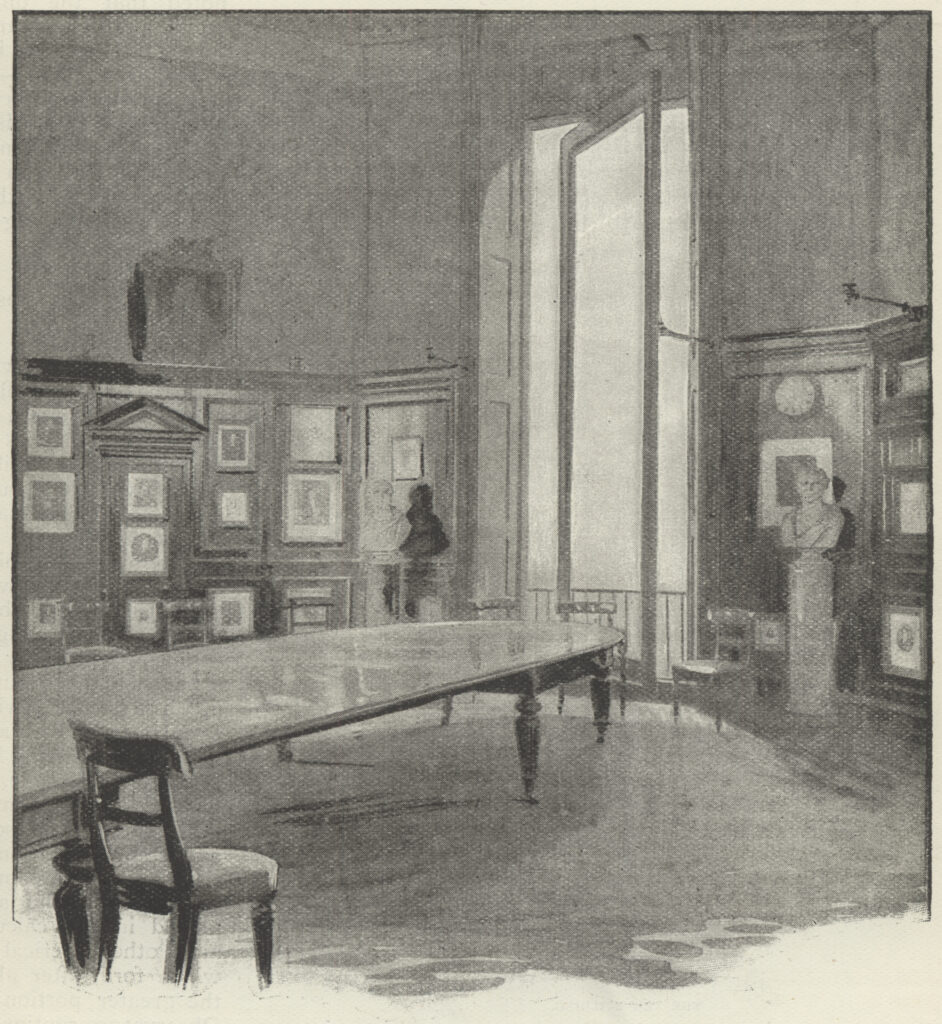
The paucity of archive material relating to Christie’s ‘lady computers’ means that we cannot find any mention of the computing table within their own words but we can at least infer the assumed role of the table by examining the workspaces of other women employed to work on the Carte du Ciel. For example, photographs of women at work in the Vatican Observatory (Blakemore, 2016), Paris Observatory (Biggs, 2000, p 96) and several observatories across Australia and Edinburgh (Stevenson, 2015, Figures 1, 35, 45, 46, 54, 74) often show them at their desks, either for the purposes of calculating or analysing star plates (Figure 4).
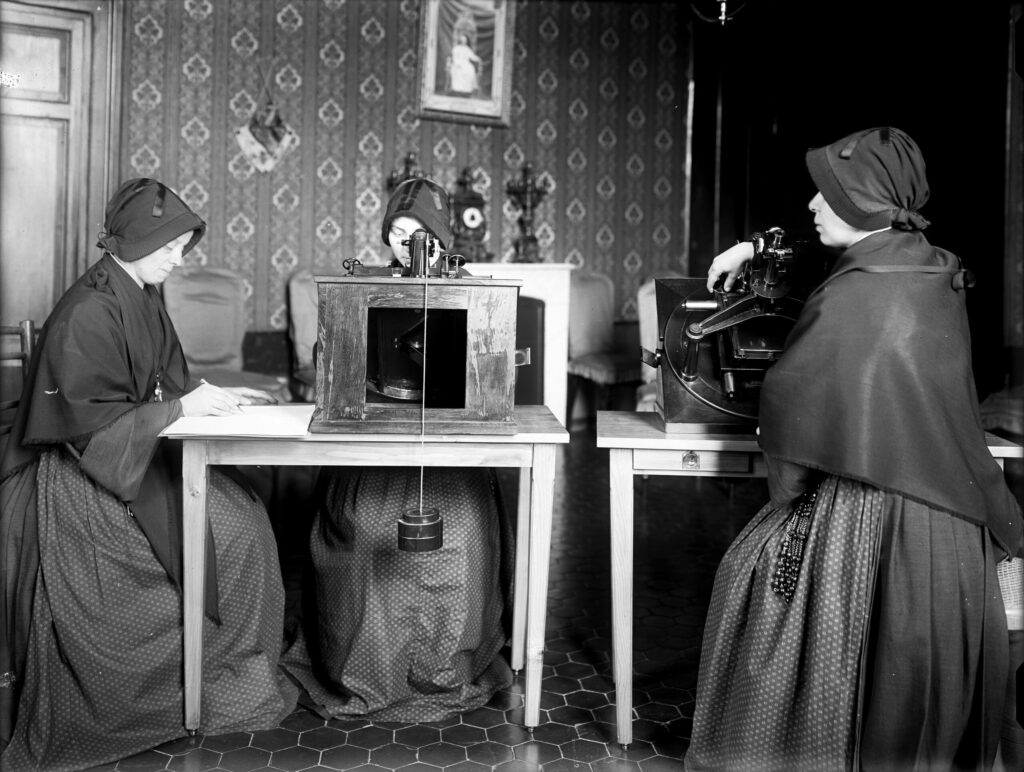
More broadly, even women working at observatories not involved with the Carte du Ciel project, such as the well-known group of female spectral analysts employed by E C Pickering at Harvard College Observatory in the 1880s, are generally shown at their desks in surviving photographs.[24] This recurring visual motif suggests that the computing table was emblematic of the women’s work and status, in a similar vein to Omar Nasim’s recent study on the iconography and cultural meaning of the astronomer’s chair, in which male astronomers were portrayed with highly specialised, functional observing chairs (Nasim, 2021). Or perhaps our perspective is skewed: it is feasible that the novelty of hiring women at observatories in this period, combined with the availability of photographic equipment, made the photography of women computers at their desks more prevalent than equivalent shots of their male counterparts.
Use as a large table for social events
Our third and final consideration of this table’s life story takes us back to its origins as a dining table. One of the first possible milestones from its appearance in the 1860s could have been the hastily arranged ‘solemn dinner’ held in the Octagon Room on 10 August 1875 to commemorate the Observatory’s 200th anniversary, in which Airy invited some visiting astronomers from Sydney and Melbourne Observatories, along with some dignitaries from the Board of Visitors.[25] At some point during the late nineteenth century, the lavish dinner for the Board of Visitors at a local tavern was replaced with luncheon in the Octagon Room; one can surmise that perhaps the availability of this extensive table contributed to the decision to host the event more cheaply on site.[26] During the tenure of the ninth Astronomer Royal, Frank Dyson (1868–1939), the Octagon Room became a social hub both for family occasions (children’s sleepovers and wedding receptions) and public events (concerts for war veterans and the meetings of the British and Foreign Bible Society) (Wilson, 1951, pp 155, 177–179, 208–209). A group photograph of Dyson’s retirement dinner, held in the Octagon Room on 1 March 1933, clearly shows numerous long tables – perhaps including our own – as the entire Observatory staff assembled to bid him farewell.[27]
In retirement: Herstmonceux, then back to Greenwich
By the 1930s, the worsening observing conditions at Greenwich forced the tenth Astronomer Royal, Harold Spencer Jones (1890–1960) to consider alternative locations. The Second World War interrupted the search but eventually the Admiralty agreed to relocate to the Observatory to Herstmonceux Castle, about 70 miles south in Sussex. It was a complex and protracted move that lasted nearly a decade (Meadows, 1975, pp 18–23). According to the Annual Report for June 1952, ‘The large oak table from the Octagon Room at Greenwich has been brought to Herstmonceux and placed in the library for the display of current periodicals and publications’ (Spencer Jones, 1958, p 4). This is confirmed by the inventory for 1972 in which we find the listing of a ‘Large Oval leaf table’ situated in the Castle’s library.[28] Given the complex and costly logistics involved in moving such a large piece of furniture, we can only assume that the table was deemed worthy of transfer, either as a practical item for future use or to be preserved as a historic Observatory relic.
Within a few decades, however, Herstmonceux itself faced closure from a combination of government cost-cutting reviews in the 1980s and the growing realisation that astronomers favoured new telescopes and reliable seeing conditions from mountain-top locations in the Canary Islands (Wilkins, 1990, chapter 6). The large table was subsequently sold in May 1990 by the Observatory’s funding body, the Science and Engineering Research Council (SERC) and was purchased as ‘office furniture’ by the National Maritime Museum. From here onwards, the table is mentioned in the records under a multitude of conflicting names and identities.[29] At first, it was simply referred to in files as a ‘Boardroom Table’ but then became known as ‘Christie‘s Computing Table’ after curators identified it as the table shown in newspaper photographs of the ‘Astronomer Royal’s room’ from 1900; yet closer inspection reveals that the seemingly long table consisted of multiple tables pushed together.[30] Given the room’s location in the ‘New Physical Observatory’, curators used these photographs to argue that the table was part of the institution’s ‘pioneering work in astrophysics’ and should be used as a working piece of furniture in the same location. By the early 1990s, the table was indeed used by curatorial staff for meetings and was somewhat affectionately but anachronistically referred to as the ‘Board of Longitude Table’.[31] Around 2009, discussions began among staff about formally accessioning the table, at which point they extrapolated from the ‘Board of Longitude’ appellation to argue its significance in computing the Nautical Almanac, rather than astrophysics. It was eventually acquired as a ‘computing table’ in July 2013 and currently remains in storage.
Conclusion
If we revisit our opening definition, we can see that this Observatory table was indeed ‘part of the furniture’: the lack of relevant details in the records is indicative of how this voluminous item was taken for granted and effectively became absorbed into the fabric of the Observatory. It is a tangible reminder of how observatories relied on a multitude of people beyond astronomers, from computers, secretaries and tradesmen through to funders, dignitaries and official guests. Compared to other objects within this issue, the table offers little insight into the Observatory’s technical and social networks themselves but instead we can appreciate its background presence in facilitating core outputs such as computations and supporting networking activities through a succession of functions and locations. As a museum object, the table has undergone a series of changing identifications and narratives, each one used by curators to argue for its significance, retention and future use.
Acknowledgements
Terry Sear and Adam Bowett of the Furniture History Society kindly provided me with advice regarding the construction, form and likely age of the table. Curator Emeritus Graham Dolan provided guidance on the RGO Inventories while former ROG Research Fellows Daniel Belteki and Lee Macdonald offered advice and further references. In addition, my colleagues at Royal Museums Greenwich did a sterling job in moving, assembling and photographing sections of the table specifically for this article; special thanks to Karen Jensen and Sam Rowland who made this mammoth task possible.
3. The Milne seismograph of Coimbra: an instrument for the making of national and international global science, by Fernando B Figueiredo
https://dx.doi.org/10.15180/232005/003Introduction
On 23 April 1909, Portugal was struck by a violent earthquake, with an estimated magnitude of 6.7 on the Richter scale. With its epicentre located in the region of Benavente, about 60 km from Lisbon, the earthquake caused 42 deaths, 75 injuries and significant damage to buildings and structures. The instrumental record of this event was made possible by the Milne seismograph, the only seismograph available at the time in Continental Portugal, located at the Meteorological and Magnetic Observatory of the University of Coimbra (OMMUC). The presence of the seismograph, installed in 1903, was due to the Observatory’s director, António dos Santos Viegas (1837–1914), and his desire to keep abreast of international developments in seismology.
Regrettably, the original seismogram record has been lost, but the 1910 annual bulletin of OMMUC provides a description:
From 13h 55m 4s of this day, the pendulum showed restlessness until 17h 40m, at which time it executed an oscillation, starting from E. to W., with the amplitude of 2mm,40 (0″,62). A series of oscillations followed that, 7 of which were larger than 17 mm,00 (4″,42), producing the displacement of the equilibrium position. The amplitude of the oscillations gradually decreased until it reached 0mm,70 (0″,18) at 18h 10m 3s, when it increased again, starting the pendulum from W. to E., and reaching the value of 1mm,40 (0″,36). It decreased again and stopped at 18h 55m 4s. Tremor domesticus. Epicentre in Benavente. Felt in Coimbra with force VI (Forel-Mercalli) (Observações […], 1910, p 148).[32]
The 1909 earthquake in Portugal generated political and scientific interest in creating a national earthquake monitoring network similar to those already established elsewhere (Ferreira, 2021, pp 203–242). It was not only a significant seismic event, but also highlights the importance of the Milne seismograph as a tool for studying and potentially preventing natural disasters.
In the last two decades of the nineteenth century, driven by the instrumental advances of seismology pioneers such as Ernst von Rebeur-Paschwitz, Emil Wiechert and John Milne, several observatories worldwide had begun systematic observation and quantitative recording studies based on instrumental measurements, paving the way for the establishment of collaborative data-sharing networks to monitor and study global earth crust phenomena. These efforts contributed to the development of seismology as a field of scientific inquiry and enabled researchers to better understand earthquakes and their underlying causes.
A seismograph is an instrument that records the movements of the ground at a given location. It generally consists of a so-called stable mass suspended from a rigid support to form a vertical pendulum within a frame that is connected to the ground. During an earthquake, this mass will tend to remain at rest due to its inertia while the frame moves with the vibrations. The change in distance between the mass and the frame is recorded (as a continuous function of time) in the form of a seismogram, which provides information about the earthquake. The sensor records the seismic signal in its three orthogonal spatial components, two horizontal and one vertical.
OMMUC’s Milne seismograph, so called because it was designed by John Milne (1849–1913), consists of a horizontal, undamped pendulum oriented to record the horizontal component of ground vibration in the East-West direction. The record was made on photographic paper moving on a drum at a speed of 1mm per minute. This kind of seismograph, as it recorded impulses in a low-velocity register, was suitable for detecting large earthquakes but not for showing the details of their waves.[33]
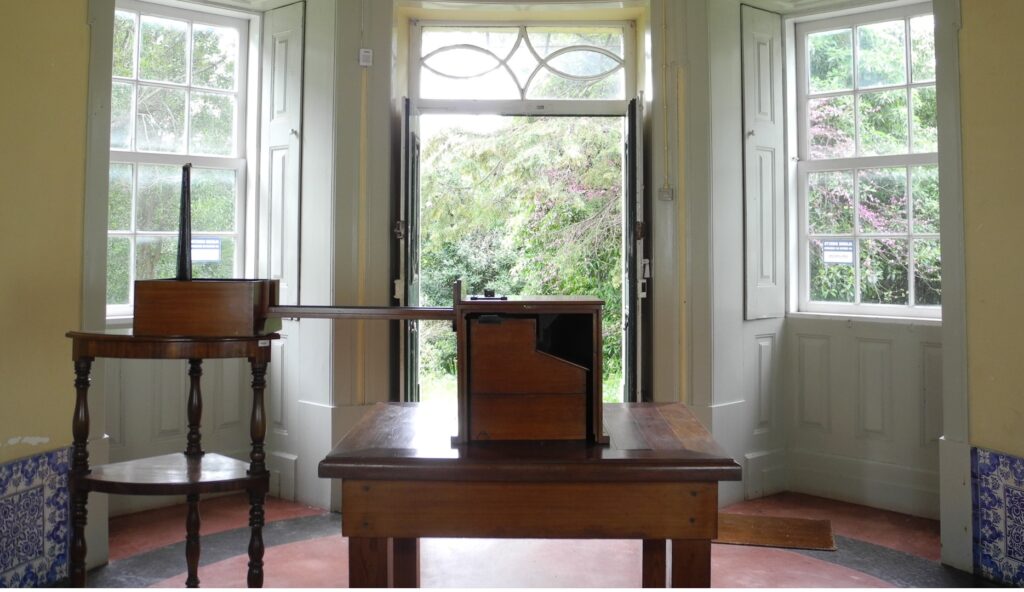

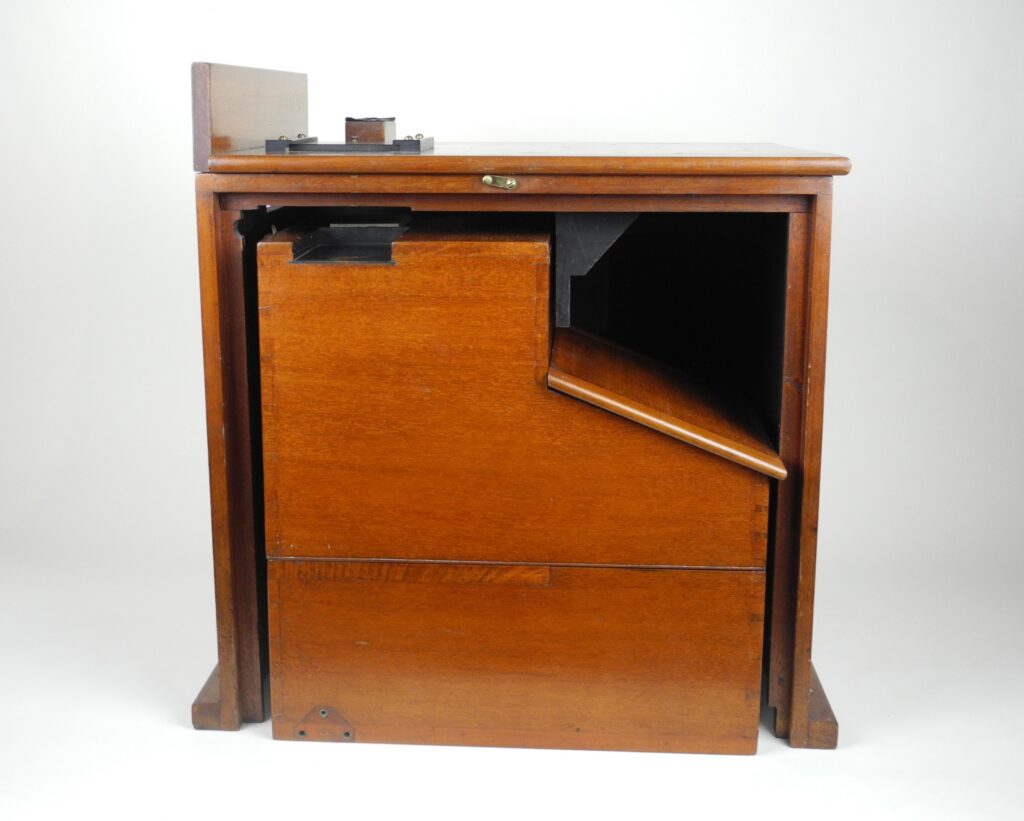
Purchased from R W Munro in 1900, the Milne seismograph only became operational in 1903, after a small building was constructed to house it.[34]
The creation of the Meteorological and Magnetic Observatory
A small orthogonal building to house the instrument was built on OMMUC grounds, about 20 metres away from the main building. OMMUC was founded in the 1860s, at a time when the interdisciplinary study of solar activity, terrestrial magnetism and meteorology was generating great scientific enthusiasm and financial support from various governments. Portugal too followed this trend, and both the Polytechnic School of Lisbon and the University of Coimbra attempted to build meteorological and geomagnetic observatories that could collaborate with their European counterparts. Several students and teachers at the University of Coimbra were encouraged to travel to European institutions and observatories to learn about their activities and scientific programmes.
In 1860, Jacinto de Sousa, a university professor, undertook one of these trips, intending to set up a future meteorological and magnetic observatory at the university (Sousa, 1861). In August and September 1860, he visited the most important observatories in Spain, France, Belgium and England. Jacinto de Sousa visited the Greenwich and Kew Observatories in London and met their directors. Kew Observatory was the world’s leading institution for research into meteorology and terrestrial magnetism. The relationships established with Balfour Stewart (1828–87) and Edward Sabine (1788–1883) would be essential for the creation of OMMUC, the building of its instrument collection and the planning of its future scientific activities, including, years later, the introduction of the study of seismology.
Construction of the observatory began in 1862. In 1864, the building was completed, entering into service with meteorological observations and records. The magnetic records began about a year and a half later, in 1866. Jacinto de Sousa’s commitment to the activity of the observatory was total. Instruments and staff were acquired, and working and observation practices began to be systematised. The aim of disseminating and sharing data with the international scientific community gained momentum with the publication of annual bulletins (Observações).[35]
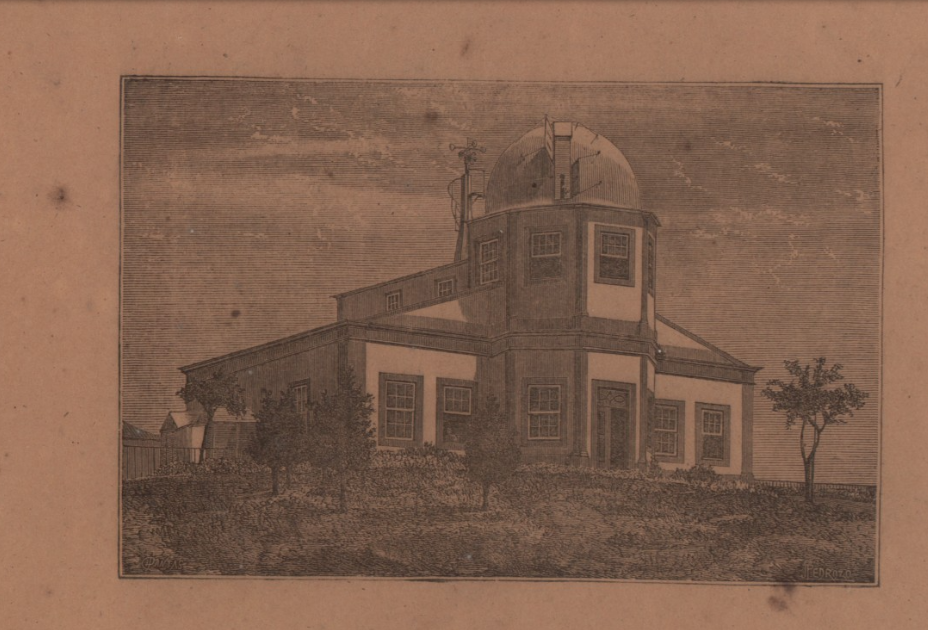
Another area seeing rapid development and research in the second half of the nineteenth century was seismology. The nature of the phenomenon was the subject of intense debate involving various geophysical issues, including the hypothesis of a possible correlation between magnetic anomalies, solar activity and earthquakes. Some scientists, including Milne, recognised the importance of exchanging seismological data internationally (Agnew, 2002, p 6; Musson, 2013, pp 794–802). De Sousa died in 1880 and was succeeded by António Santos Viegas, who was responsible for introducing seismology as a new field of research at OMMUC and for purchasing the Milne seismograph.
The establishment of worldwide seismology
John Milne, the inventor of the Milne seismograph, is often regarded as a pioneer of modern seismology for his contributions to the development and use of instruments to observe seismic motion.[36] His background was in engineering and geology, and he had a strong interest in studying volcanoes and earthquakes. In 1876, Milne emigrated to Japan to become Tokyo’s Professor of Mining and Geology at the Imperial College of Engineering. After experiencing the great earthquake of 22 February 1880, he founded the Japanese Seismological Society. Returning to England in 1895, Milne established a seismological observatory on the Isle of Wight, which became a world reference in seismic research. Many observatories that became part of the worldwide global network of seismic stations promoted by Milne were equipped with his celebrated horizontal pendulum seismograph. A relatively simple device to use, it could record ground motion caused by seismic vibration, particularly for distant earthquakes. That is why it was selected by the British Association for the Advancement of Science (BAAS) to equip seismic stations in a first attempt to make a worldwide network (Batlló, 2014, p 21).
The purchase of OMMUC’s Milne seismograph was made through Kew Observatory, which belonged to the BAAS and with which Coimbra Observatory had strong links, dating back to the time of Jacinto de Sousa and maintained under the direction of his successor, António Santos Viegas.
António Santos Viegas
Santos Viegas, who became director on De Sousa’s death in 1880, was responsible for introducing seismology as a new field of research at OMMUC and purchasing the Milne seismograph. A professor of physics and former student of Jacinto de Sousa, he also undertook some important scientific trips, representing Portugal at international scientific congresses.[37] These resulted in a number of fruitful personal and institutional contacts that were very useful for his activity at OMMUC.
At this period, research questions in electricity and magnetism, and their relationship and interactions with natural terrestrial and atmospheric phenomena, were central to the activity of the scientific community. These were areas in which Santos Viegas collaborated with scientists such as Bourbouze, Bianchi, Jamin, Verdet, Cornu, Regnault, Secchi, Thomson, Koenig, Helmholtz, Kirchhoff and Becquerel (Martins, 2020, p 178). Santos Viegas was a founder of the Société Internationale des Electriciens (1883, later Société Française des Electriciens). He was also a member of the Scientific Commission of the Internationale Elektrische Ausstellung in Vienna (1883), led by physicist Jozef Stefan (1835–1893), director of the Vienna Institute of Physics.
At the end of the nineteenth century, the scientific community was focused on the accurate measurement of geophysical phenomena, and Santos Viegas recognised the importance of this challenge. He attended the Paris Congress of Electricians in 1881, where the definitions of the five main electrical quantities were established.[38] This event had a major impact on his teaching and research activities in Coimbra. It was therefore not surprising that when the Milne seismograph was purchased, Santos Viegas insisted on having it calibrated at the National Physical Laboratory (NPL), which was the reference institution for rectifying and validating instruments, before being sent to Coimbra.
The OMMUC’s Angot and Milne seismographs
The Milne seismograph was not the first instrument used at OMMUC to try to study seismic activity. In fact, there was an earlier attempt to introduce seismology, with enquiries made about acquiring an Angot seismometer from the instrument manufacturers Breguet in Paris, probably dating back to 1887.[39] This vertically mounted instrument was commissioned on 31 January 1891 by António Garrido, as acting director of OMMUC, and installation began in late 1891, on the north-east wall of the main building, in a room that already accommodated Adie’s Baro-Psychograph (Lopes, 1893, p 203).[40] There are references to orders for ‘photographic paper for the seismograph’, and various expenses for its maintenance. However, the Angot instrument does not survive, nor is there any seismic record made with it.[41] We know that Santos Viegas was dissatisfied with its performance, but we have no information about his specific complaints. Possibly, the instrument was not very sensitive, and the recording speed low. That, at least, is what Charles Wilfrid Kilian complained of the Angot seismograph he installed in his geology and mineralogy laboratory at the University of Grenoble (Reboul, 1906, p 188).
On 23 April 1900, Santos Viegas wrote to Charles Chree, superintendent of Kew Observatory, seeking advice on selecting a sensitive seismograph for OMMUC. From then on, there was an exchange of correspondence with Chree about purchasing a Milne seismograph.[42] Procurement of one from Munro was commissioned via Kew on 5 June 1900. The letter also states that Santos Viegas wanted the instrument to be verified at the NPL before delivery, if possible, and that he would like a blueprint of installation specifications.[43] That same month, Chree informed Coimbra of the price.[44] On 30 November, Santos Viegas wrote to Kew asking for information about the delivery date of the seismograph, and on 5 February 1901, Richard Glazebrook, director of the NPL, informed Santos Viegas that ‘a box with precision instruments’ had been dispatched from London to OMMUC. On 8 February 1901, the ‘Seismographo Milne No. 31’ arrived at Oporto harbour; on 11 March 1901 it reached Coimbra.
Santos Viegas immediately began calibration of the instrument and, in the following months, made preliminary measurements, which he sent to Kew, fulfilling their request. However, it was only some two years later, in mid-1903, that the Milne seismograph was properly installed in a purpose-built building and ready for use.[45] Its regular seismic recording operation began on 11 May 1903.
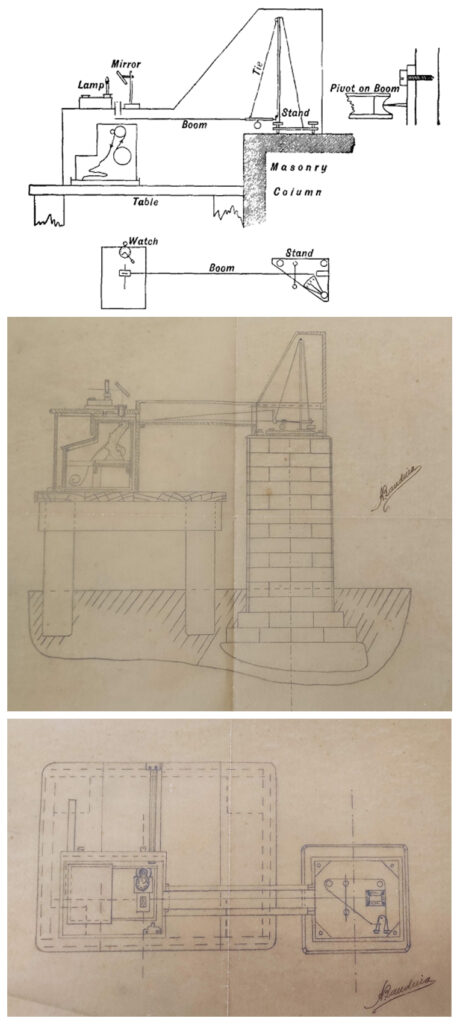
The instrument consists of an iron column on a triangular base with three screws for levelling. A horizontal pendulum hangs from the column, and its arm is made up of a light aluminium bar suspended from the top of the column by means of a cable attached to the arm. Attached to the outer end of this arm is a small rectangular plate with a slit in the centre. To balance the weight of this, a sliding mass is placed on the arm between the support cable attachment and the tip. The final plate of the pendulum enters a wooden box that rests on a solid, heavy table. This box contains the registration mechanism, which consists of a spool of photographic paper (50mm wide) with a horizontal sweep, dragged by a clockwork mechanism. The small rectangular pendulum plate is located slightly above the photographic paper (to avoid friction). A lamp and mirror are used to illuminate the photographic paper through the slit. When the pendulum arm is stationary, the resulting recording on the photographic paper is a white band with a width corresponding to that of the plate at the end of the arm. When the pendulum swings, the paper is blackened by light entering from the ends of the fixed slit.
This instrument had a natural period of approximately 20 seconds and a ground motion amplification of approximately x10 (Custodio et al, 2012, p 865). The 10m recording roll was changed weekly.
The octagonal house of the Milne seismograph
The installation of a seismic station has an essential requirement: the site must be constructed to be very stable, free from vibration or ‘seismic noise’. The seismograph should be installed on a stable base directly on the bedrock to minimise vibrations produced by human activity. Everything else for the building of a seismic station is a minor matter. As Milne wrote:
the remaining requirements for a seismological observatory are small. All that is necessary is a small one-storied structure. It should contain one or two large rooms in which to place some half-dozen instruments, and three small rooms to be used respectively as an office, a workshop and a dark room (Milne, 1899, p 489).
Santos Viegas was fully aware of these requirements. He immediately started to build a house to install the instrument and all the work inherent in routine tasks, such as changing the registration rolls and comparing and adjusting the clocks. Everything else mentioned by Milne concerning work rooms for the preparation and interpretation of seismograms was already logistically possible in the existing OMMUC facilities.
Building began in late 1901: Santos Viegas informed Chree that he had ordered the construction of a separate building for the seismograph. Despite expectations that construction would be completed ‘in the next few weeks’, it took much longer and was not completed until May 1903.[46]
The archive of the Geophysical and Astronomical Observatory of the University of Coimbra (OGAUC) does not record all the costs of construction, but the investment was undoubtedly considerable. This is evidenced by the prolonged period of construction and by the surviving payrolls for building materials and labour, which suggest some skilful financial manoeuvring on the part of the OMMUC’s director with the university rector’s office to cover significant costs within the observatory’s annual budget. It is almost certain that the building cost more than the seismograph. This highlights that, even with the attractive initial cost of the Milne seismograph, the hidden costs of its installation and operation were potentially much higher. Scientific innovation often requires substantial investment, ranging from the equipment and installation site, to accessing the collaborative networks that enhance and expand its relevance.
The house was octagonal, and its interior lined with wood to minimize temperature variations. The triangular base of the iron column supporting the pendulum rested on a masonry column attached to the bedrock, and the register box rested on a solid, heavy wooden table.
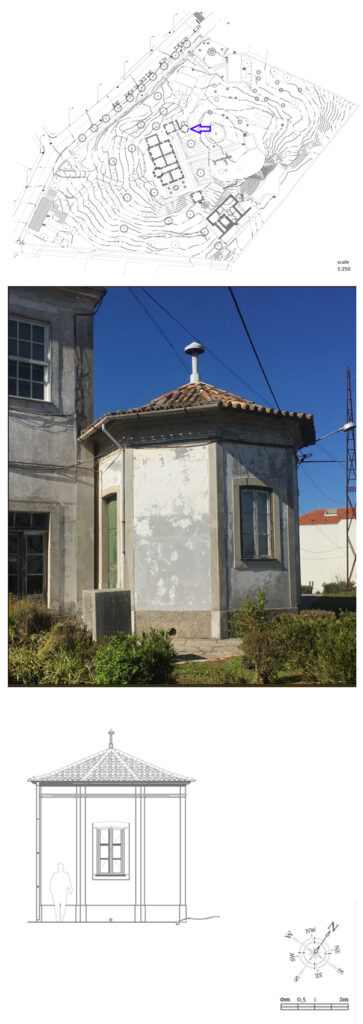
Only in May 1903 was the Milne seismograph installed and working satisfactorily. In a letter to Munro, dated 17 July 1903, Santos Viegas ordered the rolls of photographic paper for the seismograph.[47] The first roll of weekly records is dated 11 May 1903.
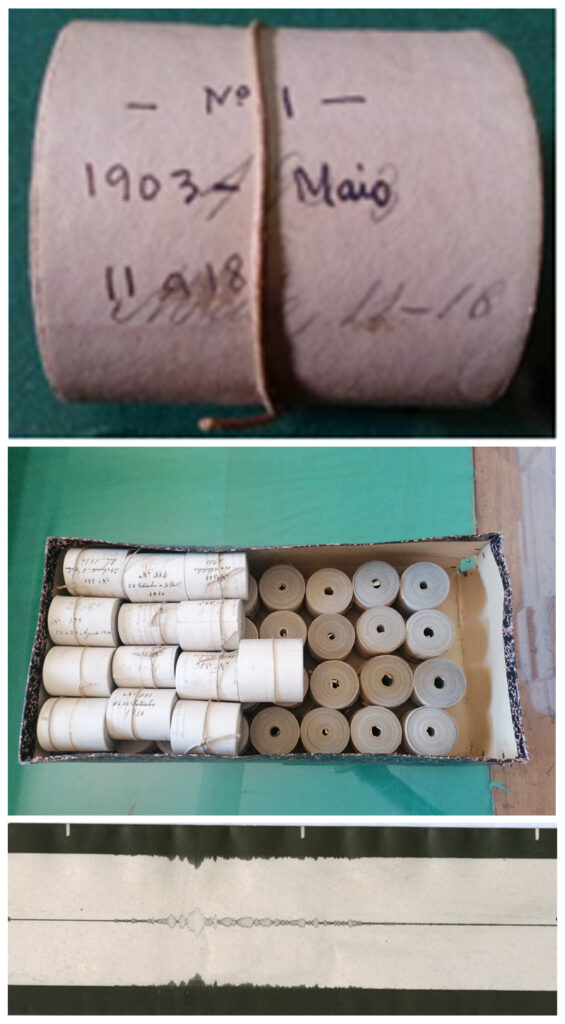
In 1907, the year of the First General Assembly of the International Seismological Association, Coimbra Observatory joined the international network that inaugurated the era of instrumental seismology. Coimbra observations were integrated into the Association’s seismic catalogue for the year 1904.
The Milne rolls: revisiting historical seismic records and the importance of archives
The history and legacy of the OMMUC Milne seismograph are significant, providing valuable insights into the early days of seismology and the way science was conducted at that time. The acquisition and functioning of the Milne seismograph were instrumental in shaping early studies of seismology at OMMUC.
The interest in revisiting historical archives of observatories with intense and continuous scientific activity has been increasing, especially with important instruments like the Milne seismograph. While the historians and sociologists of science have long been interested in such records, there is increasing attention from geoscientists. The Milne seismograph’s unique function and recording capability can provide valuable insights. It was to operate for over two decades (1903–1926), producing 841 seismic rolls (known and identified in the OGAUC archive). These rolls, together with seismograms obtained from instruments subsequently added to the observatory’s equipment, constitute an essential contribution to the study of seismology.[48] This data is a significant and unique source of knowledge about the telluric activity of our planet (Gomes et al, 2022). The Milne seismograph’s long series of records complement other datasets recording global earthquakes in the early days of instrumental seismology. For example, a study on the discovery of earthquakes of magnitude 6.0 or higher was done using the seismograms recorded by the Milne seismographer between 1903 and 1908 (Ribeiro et al, 2019). Of the 161 global earthquakes presented in international catalogues for that period, it was possible to locate 119 of them using historical data from OMMUC. That demonstrates the importance of this seismic station, the westernmost in Europe, which successfully recorded more than three-quarters of all remarkable seismic activity during that period. The re-examination of this and other comparable data has revealed earthquakes that were not identified as such at the time.
The former OMMUC collection is now part of the Geophysical and Astronomical Observatory of the University of Coimbra (OGAUC), an institution created in 2013 after the merger of OMMUC and the former Astronomical Observatory. It is of considerable importance for these different studies. A vast archive of technical-scientific production, including reports, research memoranda, articles, books and instruments, complement its collection of observational and instrumental data made over 200 years. Not only crucial for the history of science, this collection is also an invaluable resource for contemporary studies in geosciences and physics. Access to such a long series of observational data is essential for geoscientists carrying out large-scale studies and time trend analyses. Thus, OGAUC not only preserves a rich scientific past but also continues to feed and enrich current research, standing out as one of the most nationally and internationally significant institutions in this field.
Acknowledgements
Part of the research presented in this paper received financial support from the HISTIGUC Project (PTDC\FER-HFC\30666\2017), financed by the Portuguese Foundation for Science and Technology (FCT). I am grateful to my colleagues of the HISTIGUC Project, specially to Joana Domingues for her careful cataloguing /investigation of the old Milne seismograms. Thanks also go to OGAUC for the ongoing work to preserve its historical archives of geophysical data.





